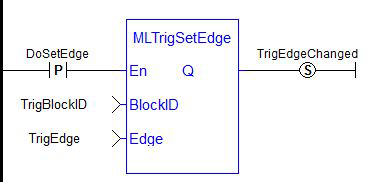MLTrigSetEdge
![]()
 Function
Function![]() A function calculates a result according to the current value of its inputs. A function has no internal data and is not linked to declared instances. - Sets the edge configuration (rising, falling, etc.) for a trigger block.
A function calculates a result according to the current value of its inputs. A function has no internal data and is not linked to declared instances. - Sets the edge configuration (rising, falling, etc.) for a trigger block.
This block should be called prior to calling MLAxisCfgFastIn. Also the value at the Edge input must match the value at MLAxisCfgFastIn’s Mode input.
Arguments
Input
Output
| Q | Description | True if block executed successfully False if execution is not successful |
|
|
Data type | BOOL |
|
|
Unit | N/A |
Return Type
BOOL
See Also
- Fast Inputs with Pipe Network Motion
- Fast Homing Example with the Pipe Network Motion Engine Axis Pipe Block
- Fast Homing Example with the PLCopen Motion Engine
- Pipe Network Registration and Fast Homing
- Registration Position Capture Example with Pipe Network Trigger Block
Examples
Function Block Diagram

Ladder Diagram

Structured Text







